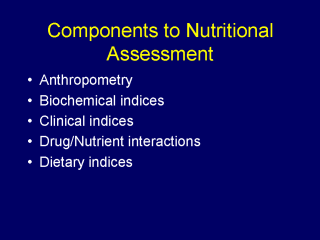| front |1 |2 |3 |4 |5 |6 |7 |8 |9 |10 |11 |12 |13 |14 |15 |16 |17 |18 |19 |20 |21 |22 |23 |24 |25 |26 |27 |28 |29 |review |
 |
Anthropometry:
study of growth. Use growth charts, and body fat measurements. There are special growth
charts available from the American Dietary Association that are for certain disabilities
(Down syndrome, Prader-Willi, Turner, Sickle Cell, Myelomengocele, premature infants). Biochemical Indices: measure levels of albumin, hepatic/renal function, iron/zinc status and vitamin status. Ex: Albumin is a protein in the blood, helps to maintain blood pressure. Vitamins A and E play a role in immune competence. Clinical Indices: physical examination of child and observation of child affect. Drug/Nutrient Interactions: look for nutrients affecting medication absorption and look for medications affecting nutrient absorption. Ex: Dilantin can affect vitamin D absorption, which can result in bone breaks and osteoporosis. Cannot be given with tube feedings, levels must be changed or will be toxic to child. Dietary Indices: 24 hours food recall, 3-7 day food record, and food frequency questionnaires (e.g."how many times per day does the child eat fruits, vegetables, drink milk" etc.) |